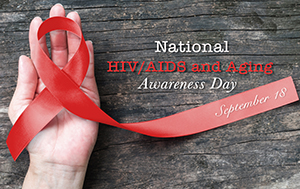Recognizing HIV/AIDS and Aging Awareness Day
Sept. 18 is National HIV/AIDS and Aging Awareness Day — a day to recognize the number of people living longer, fuller lives with HIV and the challenges that come with this reality.
Here are some current statistics on HIV, new cases and its impact:
- Stalled progress. After a steady decrease for a number of years, the amount of new HIV infections among Americans has stalled since 2013. According to the Centers of Disease Control and Prevention (CDC), the reason for this is that HIV prevention and treatment is not reaching those who need it the most.
- Greatest burden on men in the gay and bisexual community. Of the new cases, gay, bisexual and other men who have sex with men make up about two-thirds of new HIV cases.
- Transgender women a disproportionate rate of infection. A 2019 systematic review and meta-analysis found that an estimated 14% of transgender women have HIV. By race/ethnicity, an estimated 44% of black/African American transgender women, 26% of Hispanic/Latina transgender women and 7% of white transgender women have HIV.
- Many are still unaware. One in seven living with HIV don’t know that they have the condition.
- Impact on older Americans. About 17 percent of new cases of HIV occurs in someone age 50 and older. What’s particularly troubling is that this group is more likely to have late-stage HIV infection when diagnosed. This can occur because:
- Providers may not always test older people for HIV infection and older people may not consider themselves at risk.
- Older people are less likely to discuss their sexual or drug use behavior with their providers.
- The changing face of HIV. The good news is that many with HIV are now living longer, healthier lives. As a result, nearly half of Americans living with HIV are 50 years and older.
- The complications. Seniors with HIV present have special health needs. Due to their age and condition, they are at an increased risk for other conditions like heart disease, bone loss and certain cancers. Seniors with HIV also need to work with their health care providers to make sure that the medications they are taking for another condition do not interact with their HIV medications.
For more information and resources from the CDC on raising awareness and reducing new cases of HIV, please review the following websites:
- Let’s Stop HIV Together – Learn about HIV stigma and how to take action against it.
- Start Talking. Stop HIV – A campaign directed toward gay, bisexual and other men who have sex with men by encouraging discussion about HIV prevention.
- HIV Treatment Works – Features stories from those with HIV on how being active with their treatment allows them to stay healthy and live longer, healthier lives.
PrEP - An HIV Prevention Option
While there still is no cure or vaccine for HIV/AIDS, a prevention option — PrEP — does exist. If one is exposed to the HIV virus, PrEP can keep it from taking hold and spreading in one’s body.
PrEP — short for pre-exposure prophylaxis — is a combination of two drugs that are taken each day. Studies have shown that PrEP reduces the risk of getting HIV from sex by about 99 percent when taken daily. PrEP doesn’t give you any protection against other sexually transmitted diseases, so it is still recommended that those taking PrEP continue to use condoms during sex.
Although it’s reported that 35 percent of gay and bi-sexual men at high risk of HIV were taking PrEP in a recent year, the CDC notes that its usage is still too low.
Learn more about PrEP basics from the CDC and who among gay and bisexual men and heterosexuals may benefit from it.
PrEP is different form PEP – short for post-exposure prophylaxis – an emergency treatment individuals can take if one believes he or she has been exposed to HIV. PEP is effective, but it’s not 100 percent. PEP needs to be taken 72 hours after a possible exposure, but the CDC recommends starting PEP as soon as possible.
If you or someone you care for needs PEP, advise them to contact their health care provider or an emergency room caregiver. Learn more about PEP.
